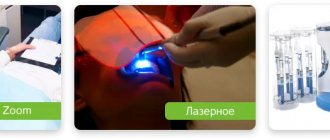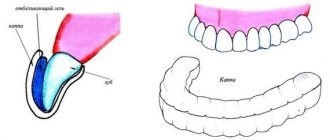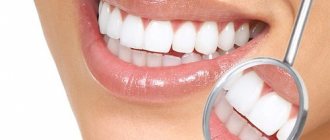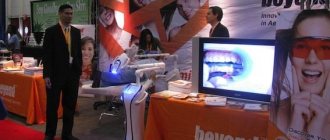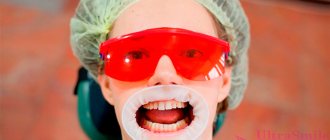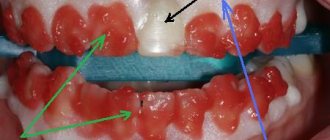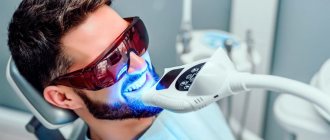What is photo teeth whitening?
Many people know the meaning of the Greek word “photos”, so they guess that light is involved in photobleaching. But what role does he play? Maybe this will be a discovery for some, but teeth are “translucent” with the usual halogen, ultraviolet or LED lamps. Can they change the color of teeth? Obviously not. Photobleaching involves the use of a special gel with 30–35% hydrogen peroxide, the effect of which is enhanced by light, which significantly speeds up the bleaching process.
When not to bleach
If there is damage to the teeth, for example, caries, wedge-shaped defect or erosion. Whitening can harm such teeth and worsen the disease. Before whitening, you should consult your dentist. He will check if there is any damage to your teeth and, if he finds anything, he will offer you treatment.
Large fillings, single veneers and crowns on the front teeth also interfere. They, unlike enamel, do not bleach. The problem can only be solved by replacing them with new ones.
You cannot whiten your teeth if your teeth have damage, large fillings, single veneers or crowns.
How does photo teeth whitening work?
One photo-bleaching session takes about an hour. First, the dentist determines the color of the patient's teeth using a standardized VITA scale. He then places a buccal retractor, which allows for better access to the dental arches. A special protective composition is applied to the gums, and a whitening gel is applied to the teeth. Then both dental arches are irradiated with a lamp for 15 to 30 minutes. After this, the “spent” gel is washed off, and, if necessary, a new layer is applied to the enamel, and the procedure is repeated. If the patient is dissatisfied with the newly acquired color of the teeth or wants to enhance the result obtained, then he may be recommended to repeat the photo-whitening procedure or additionally use a home whitening system.
Whitening systems
Today there are two most popular whitening systems – ZOOM 4 and Opalescence. Each of them has its own characteristics and advantages.
ZOOM 4 is an improved version of the ZOOM and ZOOM 3 systems. This is a relatively new procedure developed in America, however, it is already actively used throughout the world, proving its high efficiency and safety.
Features and Benefits of ZOOM 4
- High efficiency. Whitening from 8 to 12 tones is possible. The desired level of whitening is discussed in advance with the dentist during a preliminary consultation and determination of the initial enamel shade according to the VITA scale.
- Long lasting results. Subject to continued proper dental care and compliance with the dentist’s recommendations, it is possible to consolidate the effect of the procedure for up to five years.
- Teeth whitening services using the ZOOM 4 system can only be obtained in a dentist’s office. This minimizes the risk of complications and is made for the safety and greater effectiveness of the procedure. ZOOM 4 technology provides all the necessary protective measures. Unlike ZOOM 4, teeth whitening with the Opalescence system has options for use at home.
- When whitening with the ZOOM 4 system, the dentist uses two components: a special gel and a lamp with ultraviolet radiation. Zoom Gel is an acid-free whitening formula using hydrogen peroxide. Zoom gel is applied during the procedure three times within 45 minutes. Ultraviolet light, in turn, is used each time the gel is applied to activate it, break up spots and remove pigmentation.
- The minimal impact of the lamp on the enamel and the composition of the ZOOM gel (1/4 hydrogen peroxide) significantly reduces the risk of developing hypersensitivity after the procedure. In addition, before using the ZOOM 4 whitening system, the dentist applies a special protective cream to the gums, installs a retractor, provides you with safety glasses, and before and after the procedure uses a special calcium-containing composition (to strengthen the enamel).
- To achieve better results, the first time after the procedure, you should exclude coloring foods and drinks from your diet - grapes, wine, coffee, tea and others. In addition, it is strongly recommended (at least temporarily) to quit smoking.
- The result is noticeable immediately after the procedure.
- The need for remineralization of teeth to consolidate and improve the result. This therapy involves restoring the enamel and enriching it with microelements.
- The teeth whitening procedure with the ZOOM 4 system is painless and does not cause any discomfort to the patient.
- A whitening session, including preliminary preparation, takes about two hours.
- Even the most sensitive teeth tolerate whitening with the ZOOM 4 system well.
- The procedure is effective in most cases, including age-related yellowing of tooth enamel.
- In some cases, the preparatory period to strengthen the enamel before the procedure lasts 7–10 days.
Opalescence whitening system
Opalescence is a chemical whitening technique that is widely popular among dentists and patients today.
Features and Benefits of Opalescence:
- There is no need to use bleaching gel activating agents - llama or semiconductor laser. Activation occurs naturally as a result of the reaction between the components of the gel immediately after its application.
- A large number of options for Opalescence systems. A large selection implies the ability to choose the ideal option, taking into account the characteristics of the teeth and the desired level of whitening. There is a teeth whitening system Opalescence Boost (achieving the fastest effect, deep whitening, the possibility of intracoronal whitening of pulpless teeth), the Opalescence PF system (specially designed for sensitive teeth), intracanal whitening Opalescence Endo (for deep tooth pigmentation) and Opalustre suspension (for surface defects ).
- Opalescence produces systems for both professional and home whitening.
- Opalescence Endo systems and Opalustre suspension are supplied ready-made and do not require the dentist to mix the components.
- The whitening procedure itself lasts about twenty minutes (if there is no need to reapply the gel).
- Before the procedure, the dentist first dries the teeth and applies a protective paste. After whitening, teeth are treated with enamel-protecting agents, which reduces the risk of sensitivity.
- The Opalescence home whitening system allows you to whiten your teeth by 3-4 tones, as well as consolidate the effect after professional whitening.
- Maximum lightening up to 8 tones.
- Lower price compared to other whitening methods.
- Failure to comply with safety precautions may result in a chemical burn.
It should be taken into account that whitening procedures require careful preparation - treatment of carious cavities (if any), gum diseases, plaque removal and tartar removal. If the procedure is carried out without preliminary professional cleaning, uneven whitening and the development of side effects are possible.
Efficiency of photobleaching
You can usually whiten your teeth several shades. But the results of whitening, as well as its durability, regardless of the technique, are always individual. In many ways, the achieved effect depends on the natural shade of the teeth and the reasons for its change. For example, yellow teeth are more susceptible to lightening than gray teeth. A coffee or cigarette lover will be more likely to be satisfied with the results obtained, but someone with tetracycline teeth or fluorosis will probably waste their time and money. Therefore, if you are interested in the issue of effectiveness, then reviews from friends and colleagues about photo teeth whitening are unlikely to be useful to you. “I want teeth whiter than my girlfriend’s!” – You shouldn’t make such a request even to the best specialist. If you need a guaranteed result, it makes sense to think about installing lumineers, which quite effectively solve the problem of yellow teeth.
Zoom: before and after photos
Reading reviews of Zoom teeth whitening (which we will also present later in this article) you will see that many patients note a good effect from the procedure only if the teeth were initially quite yellow. In this case, the “before and after” effect of whitening is visible quite well. If you want to make already quite light teeth whiter, the effect will be practically unnoticeable.
Teeth whitening Zoom-4: before and after photos
Photo whitening and tooth sensitivity
Increased tooth sensitivity may occur as a result of exposure to chemicals and high temperatures. The solution to this problem is proper preparation for photobleaching. Before the procedure, the dentist must conduct an examination of the oral cavity in order to identify the presence of chips and cracks, caries, gum disease and other factors that may be a contraindication to whitening and must first be eliminated. In addition, before photo-whitening, professional hygiene and remotherapy are recommended, as well as the use of special pastes that eliminate hypersensitive teeth.
Caring for your teeth after whitening
In order for a snow-white smile to please you for a long time, you need to follow simple rules after the procedure.
- Brush your teeth after every meal. Brushing should be done with a soft toothbrush and toothpaste that reduces tooth sensitivity.
- Use mouth rinses designed to strengthen tooth enamel.
- After eating, floss to prevent food from accumulating between your teeth.
It is also not recommended to smoke for several hours after the procedure and use lipstick, as its coloring substances can get on the enamel of the teeth.
Caring for your teeth after whitening
Since teeth are more susceptible to staining after whitening, you should follow a special white diet for two weeks. It involves temporarily avoiding those products that have strong coloring properties. These products include: carrots, tomatoes, beets, blueberries, cherries, currants, chocolate, coffee, tea, wine, juice, soda, and bright seasonings.
After a two-week diet, you can gradually return familiar foods to the menu.
By following these rules after whitening, you can maintain not only a beautiful smile for a long time, but also maintain the health of your teeth.
Summary table of whitening techniques
Table
| Teeth whitening procedure format | Products/techniques | Duration of the procedure | Whitening zone | Duration of effect after teeth whitening (subject to diet and smoking cessation) | Cost (RUB) in Moscow* | Aesthetic result |
| Home teeth whitening | Pastes, strips, sticks | 21 day | all teeth | 1-2 months | 500 rub. for the “paste + brush” set | up to 2 shades lighter |
| Mouth guards | 2-6 weeks | all teeth | 6 months | 5 000 – 16 000 | up to 4 tones | |
| In-office teeth whitening | Photobleaching | 50-60 min. | "smile zone" | up to 5 years | 4 000 – 20 000 | 5-12 tones |
| Laser whitening | 20-30 min. | "smile zone" | up to 5 years | 7 500 – 30 000 | 5-10 tones | |
| Chemical bleaching | 30-90 min. | "smile zone" | up to 5 years | 5 000 – 22 000 | 5-10 tones | |
| Endobleaching (intracoronal) | depends on the chosen technique | locally | up to 2 years | 500 – 1 700 | maximum up to 2 tones | |
| *according to the portal www.startsmile.ru | ||||||
Gel in universal mouth guards
Universal trays with Opalescence TresWhite Supreme whitening gel. Price 4,500 rubles.
Unlike individual ones, universal mouthguards are disposable. They do not need to be made in the dentist's office. They are made of elastic material that fits any shape of the dentition. The downside is that they are opaque and bulky. Because of this, they are visible to others and can interfere with conversation. These mouthguards are best worn at home or during periods of time when you do not need to communicate with anyone.
For universal aligners, you do not need to buy whitening gel. The manufacturer sells them in protective packaging and pre-fills them with a viscous gel that does not leak. True, the gel concentration is only 10%.
Universal trays with Opalescence TresWhite Supreme whitening gel. Price 4,500 rubles.
- Remove the mouthguard from its protective packaging
- Take the holder and place the mouth guard in the center of the teeth
- Lightly bite or press the mouthguard with your tongue
- Pull the holder and remove the top color layer
- Use your tongue to spread the white inner layer
- Repeat with the second tray
- Throw away the mouthguard after use.
The manufacturer recommends wearing the mouth guard for 30 to 40 minutes a day. But it is better, as in the case of an individual mouthguard, to consult a dentist. You should always remember that each tooth shade needs its own whitening regimen.
Universal mouth guards are sold with gel, but they are not as comfortable.
Home whitening with both types of aligners can be done no more than twenty-eight days a year, twice for two weeks.
How not to whiten teeth
Powders with large particles , such as tooth powder, baking soda and activated carbon. These are powerful abrasives. They scratch enamel more strongly than abrasive pastes with the highest RDA rating. The enamel becomes rough. Microbes settle on it more easily and begin the carious process.
Highly acidic foods such as lemon, orange or apple cider vinegar. Their acid disrupts the acid-base balance in the mouth. As a result, minerals are washed out of the enamel and erosion appears.
Erosion of the enamel of the upper incisors due to teeth whitening with non-intended means
The principle of operation is similar to whitening with professional means. The difference is that in professional products the acid concentration is designed for optimal and safe action. If you follow the recommendations during whitening, there will be no harm.
Food “bleaches” contain a high concentration of acid. Drinkers of freshly squeezed orange juice sometimes suffer from enamel erosion even though they simply drank the juice.
You cannot whiten your teeth with powders with large particles and highly acidic foods.
Gel whitening in individual trays
Whitening gel Opalescence PF. Price 2,250 rubles.
For such whitening, you need to go to the dentist and ask for a custom mouth guard. These mouthguards cannot be purchased anywhere. To make them, the dentist will take impressions of your teeth and make aligners exactly based on them. They completely follow the shape of your teeth and will not suit anyone else. For the same reason, other people's mouth guards will not suit you.
Custom mouth guards are virtually invisible to others when you are talking or smiling. You can wear them not only at home, but also at work, meetings or other events. The downside is that you can't eat in them.
You also need to find out from your dentist what concentration of gel to use and how long to use it. Each tooth shade needs a different whitening regimen. Whitening gel of different concentrations is sold in syringes with a convenient thin spout.
Whitening gel Opalescence PF RUB 2,250.
- Prepare the mouthguard, rinse and dry it
- Squeeze the gel from the syringe into the mouth guard so that it covers the entire inner surface with a thin layer
- Place the aligner in the center of the teeth
- Secure it onto your teeth using finger pressure. Upper - with thumbs, lower - with middle and index fingers
- After use, rinse and dry the mouthguard
Gradually, day after day, the result appears. The concentration in home whitening gels is quite low, from 10 to 20%, but this is compensated by long-term exposure. According to research, no harm from such bleaching has been found. The main thing is not to wear a mouth guard for longer than the dentist recommends.
The mouth guard will last longer if stored in a special container.
Individual mouthguards are reusable. You just need to rinse and dry them after use. You can buy a special container for storage. It protects the mouth guard from dust and damage.
Whitening with gel in an individual tray is the most aesthetic and convenient. But an individual mouthguard must be made by a dentist, and the gel must be purchased separately.
